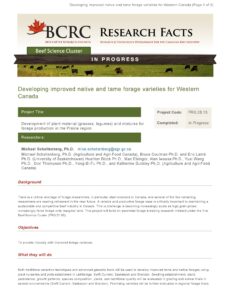Developing Improved Native and Tame Forage Varieties for Western Canada
A reliable and productive forage base is critically important to maintaining a sustainable and competitive beef industry in Canada. Cattle producers need access to high yielding, high quality, and well adapted forage varieties to improve the economics of production, which is becoming increasingly challenging as high grain prices continually force forage onto marginal land.
Research currently underway, funded by the National Check-off and Canada’s Beef Science Cluster, is working to provide Western Canada’s beef industry with a package of improved tame forages (hybrid brome, meadow brome, crested wheatgrass and alfalfa) and native forages (northern wheatgrass, blue bunch wheatgrass, prairie sand reed, nodding brome grass, purple and white prairie clovers, Canadian milkvetch, ascending milkvetch and slender milkvetch).
In Canada there is a critical shortage of forage researchers, in particular plant breeders, and several of the few remaining researchers are nearing retirement. This research program will also train and mentor two PhD’s and one postdoc in forage breeding, genomics, and ecology/agronomics, which will help to address some of the forage research capacity issues of great concern.
Click here to subscribe to the BCRC Blog and receive email notifications when new content is posted.
The sharing or reprinting of BCRC Blog articles is welcome and encouraged. Please provide acknowledgement to the original author and let us know you chose to share the article by emailing us at info@beefresearch.ca.
We welcome your questions, comments and suggestions. Contact us directly or generate public discussion by posting your thoughts below.
